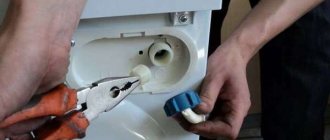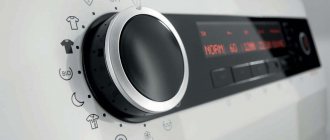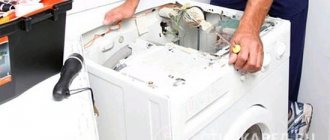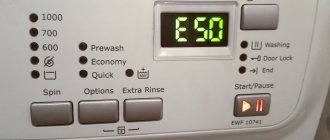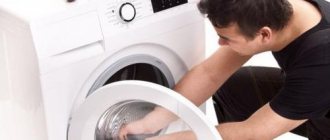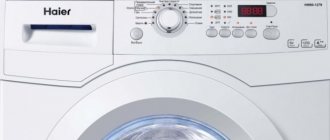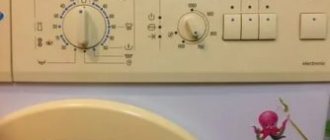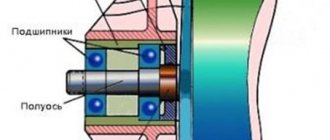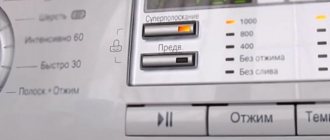Error codes for Aeg washing machines are displayed on the front panel; most often they are a combination of letters and numbers, by which it is easy to determine the type of failure. Washing machines are equipped with special sensors that allow them to carry out preliminary self-diagnosis.
That is why, when a failure occurs and execution of a built-in function or an entire program is impossible, a person sees this or that code. It is necessary for an ordinary user to know the decoding of the values, since in some cases this will help in eliminating the breakdown - if it is minor, then you can return the machine to operation on your own without contacting a service center.
Problems with water supply or drainage
Some of the most common types of breakdowns include water-related problems. It may not enter the tank or drain. The following codes indicate violations of functionality (they are displayed on the display or at the time of diagnostic measures on the specialist’s special equipment):
- code E 11 - the washing machine did not collect a sufficient volume of water within the allotted time period to fill the container to the required level or water does not enter the tank at all. Usually, if there are no malfunctions in the functioning of the unit, all actions should take place in less than 10 minutes. In this case, before contacting the service center, you need to check whether the water is turned on and whether the drain hose is connected correctly. Another possible cause of malfunction is a broken fill valve or clogged filter;
- code E 12 - water does not collect well during the main stage of washing - problems can be solved by analogy with the previous error, and also, in the case when during the collection of water it immediately drains, you need to additionally check whether it is correctly connected to all nodes and directly drain hose for Aeg washing machine;
- code E 13 - there is a leak of varying intensity (water enters the tray of the washing machine or flows out onto the floor) - this can be caused by a failed drain pump (in 95% of cases a replacement is necessary), there are problems with the dispenser, hatch pipe and tank. It is recommended to seek the services of a workshop even if only drops of water are present;
- code E 21 - water does not drain from the Aeg washing machine for more than 1 minute, the time set in the program selected for the washing process has been exceeded (up to 10 minutes). Reasons that can lead to this: clogged drain hose or its deformation, clogged drain filter, faulty pressure switch or drain hose;
- code E 22 - water does not drain well (spin/dry stage) - causes similar to the previous failure can lead to breakdown (E 21);
- code E 23 - failure of the control triac of the drain pump - in most cases, the problem can only be fixed in a workshop, since the reasons are the malfunction of the triac (replacement), violation of the integrity of the electrical wiring (replacement of the damaged section is required), breakdown of the drain pump (diagnosis and possible replacement of the part ), control module failure.
Errors related to the supply or pumping of water include code E 24 - in this case, disturbances appear in the control circuit of the drain pump triac. The problem can only be fixed in a workshop, since repairs will require disassembling the controller.
[custom_ads_shortcode1]
Tap water purification products
Existing methods for purifying tap water from metal salts, rust, sand and other small impurities can be divided into two large groups: mechanical and chemical.
Mechanical methods are based on the use of special mesh filters with very small cells. They remove only mechanical impurities from tap water: rust, clay, sand. The degree of purification depends on the size of the cells. The filters themselves can be non-washing or self-washing. Most often they are used for preliminary (rough) cleaning.
Chemical methods involve the use of various minerals (shungite, silicon) and sorbents (resins, activated carbon). They remove heavy metal salts, fluorine, chlorine and organic matter from water. The number of purification steps and the type of reagents used directly affect the specific list of substances to be removed.
Problems and malfunctions of sensors in the tank
Owners of aeg washing machines may encounter a number of errors related to tank sensors. Their codes are as follows:
- error code E 31 - the sensor signal exceeds the permissible level (the pressure switch is faulty) - reason: sensor malfunction (diagnosis and replacement required), the occurrence of this error in Aeg machines may also be affected by faulty contacts or the sensor circuit (needs to be restored or replaced), damage in the control module;
- error code E 32 – irregularities in the calibration of the pressure sensor. During the draining of water, an unstable frequency passes through. The following reasons can lead to a problem: the drain hose is defective or clogged, there is a blockage in the drain filter (needs to be changed or cleaned), a blockage in the drain tract (various sections), the integrity of the wiring is compromised, the contacts are loose, there are malfunctions in the control module ;
- error code E 33 - there is an inconsistency in the operation of the main sensors of the AEG washing machine (pressostat, heating element protection, first level sensor) - the following reasons can lead to the appearance of this code: failure of the sensors or one of them, blockage in the hydraulic system (filters, tubes ), in this case a thorough cleaning should be performed. A sudden surge in electrical voltage, even if it is brief in time, can cause a malfunction. You will need to check the functionality of the outlet to which the Aeg washing machine or extension cord is connected, and call a specialist electrician. Another common cause of malfunction is a breakdown of the power supply with leakage to the heater body. In order to get rid of it, you need to check all existing contacts and wires.
You need to pay attention to the following (frequently occurring) types of breakdowns:
- error code E 34 – inconsistency in the operation of the pressure sensor and the anti-boiling level sensor. The problem may be due to the fact that one of the sensors has failed and requires repair or complete replacement. There could also be a blockage in the pressure sensor - in this case, you must first clean the tubes leading to it. Another reason is disturbances in the pressure switch circuit;
- error code E 35 - it indicates that the water in the tank has crossed the permissible level. Reasons: breakdown of the water intake valve (you will need to undergo diagnostics and, if necessary, repair or replace the part). Also, the causes of failure may include a blockage that has occurred in the level sensor or a breakdown of the sensor. A malfunction of the control module leads to the display of this code on the display of the Aeg washing machine;
- error codes E 36-37 - the heating element protection level sensor/first water level sensor does not work - solutions in each case involve replacing these parts;
- error code E 38 - it occurs when, during rotation of the drum, a difference in the water level in the tank occurs, which is recorded by the pressure switch for 30 seconds or more. The causes of the problem may be related to a blockage that has occurred in the sensor pipe (thorough cleaning is required), or the pressure switch itself may break; this can be solved by carrying out diagnostics in a workshop and subsequent replacement.
Error codes E 39-E3A are associated with breakdowns of the water overflow sensors and the heating element relay (removable by diagnostics, repair or replacement in a workshop). You need to understand that all breakdowns that occur are not a consequence of poor quality equipment, but a normal element of operation when parts fail.
[custom_ads_shortcode2]
Errors indicating a malfunction of the hatch
In the case when the Aeg washing machine has problems with the hatch, error codes E 41-45 are displayed on the display or screen. Problems may include:
- the hatch closes, but sufficient density is not observed (gaps are visually visible) - code 41. In this case, you need to try closing again, if this does not help, then you need to contact the workshop;
- The hatch is not closed at all. The problem in 90% of cases is related to the failure of the locking system. The element can be replaced in a workshop; the unit first undergoes diagnostics. The error code in this case will be E 42;
- A problem with the hatch may arise due to the failure of the locking device (UBL). It will not be possible to correct error 43 on your own, since this element is located on the electronic controller. Since the device is complex, containing many electronic components and small parts, it will not be possible to fix the breakdown on your own; only a specialist will be able to carry out the repairs that are required in this case;
- There is not even a weak signal that comes from the sensor that regulates the process of closing the hatch. The error code in this case will be E 44. In this case, the first steps to resolve the negative situation will be to check the contacts and, if necessary, tighten them.
Important! Particular attention should be paid to the wiring that goes to the sensors. It must be ringed carefully (special instruments are used).
If damaged areas are found, then if a person has enough knowledge, then they should be replaced. If the problem persists after this and the hatch cannot be closed, then there is a high probability that there is a malfunction in the sensor itself. Elimination involves a complete replacement of the device, which is carried out in a workshop or service center.
If code E 45 is displayed, it informs the user that there are violations in the UBL sensor circuit. The causes and main factors may be disturbances in the electronic controller. All repair and testing actions must be carried out by specialists, since the device is complex and requires special knowledge.
[custom_ads_shortcode3]
Electrolux brand store
You are on the website of the Electrolux branded household appliances store. All products presented in our catalog are original and have a 12-month manufacturer's warranty. All equipment in Russia is repaired by authorized service centers, which are carefully controlled by the company and provide consumers with a premium level of service.
The user can visit our branded showrooms in Moscow and St. Petersburg, and also order courier delivery in both capitals, Moscow and Leningrad regions. Residents of other regions of Russia can order fast and careful delivery of Electrolux equipment using independent transport companies. All visitors to our website have access to free professional advice from experts in the field of household appliances. You can contact them by phone or through a special online assistant form.
Source
Errors from different categories
An error with the numerical value E5A indicates that the temperature of an element such as a cooling radiator exceeds the maximum permissible value for this part (the maximum should be no more than 88 degrees). The only way to get rid of the problem is to completely replace the failed device. For this purpose, the Aeg washing machine must be taken to a workshop, and replacement work can only be carried out by specialists.
E5V is a designation that indicates that the voltage in the DC bus is critically reduced (a value not lower than 175V is allowed). Ways to solve this problem suggest that you will need to check the internal wiring that is located in the washing machine (in the entire unit, and not in any specific segment). If the work does not bring positive results, then it is necessary to carry out diagnostics and then repair the control board or completely replace it.
Indicators E5C notifies that the voltage readings exceed the maximum permissible in this case of 430V. The solutions and algorithm of actions are similar to the previous version of the errors.
Error codes for Aeg washing machines also indicate problems that are associated with the heating element. One of the numerical designations is E61. If this data is visible on the screen, then with a high degree of probability difficulties arise due to the fact that the water in the tank does not heat up or does not reach the temperature set by the washing program. It is difficult to recognize a problem without special equipment, since the corresponding symbol is displayed only during the diagnostic process, which cannot be done at home.
A malfunction in the temperature sensor is a factor that needs to be paid attention to, since it could be the cause of a problematic situation (the solution is replacement). There may also be a break in the electrical circuit responsible for controlling the heating element of the washing machine. To start eliminating it, you can ring it at home, then tighten up all the contacts.
If knowledge allows, you can repair places where the wiring is damaged. If the heater burns out, then only its complete replacement will help return to normal operation.
[custom_ads_shortcode1]
Program table
| Program | Description |
| Cotton | White and colored fabrics of varying degrees of soiling |
| Cotton Eco | The most energy efficient program. For washing white and colored items |
| Synthetics | Synthetic fibers and mixed fabrics. |
| Delicate | Viscose, acrylic, polyester. |
| Wool/silk | Woolen items for machine or hand washing with appropriate markings |
| 20 minutes 3 kg | Lightly soiled cotton or synthetic items. |
| Blankets | Bedspreads, synthetic blankets, quilted clothing and down jackets |
| Sport | Clothes made from synthetic fabrics that require special care |
| Drain and spin | All fabrics except wool and items requiring special care |
| Cold wash | Cotton and mixed fabrics at 20°C |
Sensors and heating elements
Problems can arise with the heating element sensors and directly with the heating element of the washing machine itself. The E 68 value is displayed when there is an electric current leak directly through the heating element. It goes to the body of the washing unit. The main reason that can cause such a breakdown is a violation in the electrical wiring. To eliminate the malfunction, you need to replace the damaged areas. If you do not have sufficient knowledge, you should seek professional help. The heating element itself may also fail - in this case, a check of its functionality will be required, followed by repair or complete replacement.
E 69 – the value indicates a malfunction on the resistor of the heating element control board. The reasons may also be related to burnout in a section of the circuit (you need to first ring the wiring, then replace it). Additional problems - the thermal fuse contacts turned out to be open.
The solution is to replace the damaged part. If the board is faulty, it needs to be replaced.
E 71 - problem in the operation of the temperature sensor - unacceptable resistance. Causes:
- short circuit;
- disconnecting contacts;
- violations in the wiring circuit;
- malfunction of the sensor itself;
- failure in the main board.
Ways to solve the problem are diagnostic measures, ringing the circuit and replacing damaged areas, diagnostics and replacement of the sensor or board. Similar problems may arise when E values 72-73 are displayed.
[custom_ads_shortcode2]
Service test for AEG washing machine
In some cases, the question arises: how to reprogram the machine? New models are equipped with a self-diagnosis function, but in older models you can do the test yourself.
Entering diagnostic mode:
- Cancel the set program and switch off.
- Press and hold the start/pause and exit buttons. Turn on, then turn on and turn the knob one notch clockwise.
- Hold down the start/pause and exit buttons for about 5 seconds until you switch to diagnostic mode).
- To exit the mode you need to turn it off, turn it on and turn it off again.
How to delete memory contents (errors):
- Switch to diagnostic mode and turn the program selection lever to position 10 (display).
- Press the start/pause and exit buttons simultaneously and hold until the data is deleted.
30.08.2018
Malfunctions of electronic components
Problems may arise with an electronic component included in the washing machine. In this case, the corresponding values will appear on the screen. E 91 - indicates that there was a failure in the process of transmitting information between the washing machine control module and the display to which the information is received. Causes of failure - there are damaged sections in the circuit between these two elements. Dialing and troubleshooting should be carried out.
If this does not help, you need to replace the damaged part. The imaging board may also be faulty and will require diagnostics, replacement or repair. Similar problems are observed if error code E 92 occurs.
In this case, the reasons may include a mismatch between the boards (needs replacement) or a failure in the system board (can only be fixed by service). E 93-94 is displayed - incorrect data on the configuration of the washing machine. To eliminate it, you need to specify the correct values; there may also be a malfunction in the control module - in this case, service repair is required.
Error E9B - indicates that there is a violation of data exchange between the microprocessor and the memory of the washing machine. Such a breakdown can only be repaired by service.
[custom_ads_shortcode3]
Problems with the drying system
Breakdowns may be due to drying. Designation series Ed 1-4. The board and host system may also fail.
You need to check if there is any damage in the circuit. The board may also break (require replacement). A breakdown of the resistor relay may also occur.
In this case, you need to check not only the circuit, but also the contacts; the sensors may also fail. You can also find out that the dryer requires repair by reducing the quality of its functions (the laundry will be damp).
[custom_ads_shortcode1]
Meaning of this error
What does the displayed code tell you? Having studied the operating instructions for the AEG machine, you can understand that this designation indicates an insufficient amount of water in the tank or its absence. This interpretation of the code is quite extensive, since in reality there are several reasons for the appearance of E10. The washing machine may display an error on the display if:
- lack of water in the water supply (in case of internal shutdown of cold water supply);
- defective water intake hose;
- Fill valve malfunction;
- failure of the pressure switch;
- presence of self-draining water from the tank.
Self-draining is the spontaneous leakage of water from the SMA tank due to some kind of breakdown.
Some washing machines that have a fairly extensive database of error codes can clarify the reason for stopping the normal operation of the unit, indicating a specific malfunction in the system. However, most AEG machine models do not have this capability, so they issue a general code E10. If the washer does not specify which part has failed, when carrying out repairs with your own hands, you will have to keep all the above factors in mind.
[custom_ads_shortcode3]
We are looking for the reason for the appearance of the code
If a fault code in an AEG machine is displayed on the digital screen, it is necessary to examine, one by one, the main elements of the washing machine system responsible for collecting water and draining waste liquid. It is right to start inspecting the unit with the simplest one, the one for which you do not need to climb deep into the body of the machine. It is logical to check the parts to which you have easy access, since in 90% of cases the malfunction can be corrected at the household level.
Let's look at what actions need to be taken to confirm or refute each of the named factors leading to error E10. The first reason given was the lack of water in the water supply network. There is no need to explain how to see if there is water in the pipes, since even a child can check it.
The next point is a defect in the inlet hose. This could be due to blockage, bending, damage, etc. What to do in this case?
If a water filter is installed in front of the hose, you need to remove the cleaning element and examine it - it is probably clogged with debris and deposits, and that is why water does not flow into the tank. If there is no filter or it is not clogged, check if there are any kinks or kinks in the hose. Then you should check the tightness and reliability of the connection between the water intake hose and the water pipe, as well as the hole in the washing machine.
When the water intake system into the tank is fully operational, it is necessary to examine the unit for the presence of self-draining liquid. To do this, you should lean against the body of the washing machine and try to hear the water leaving the tank and murmuring in the drain hose. Since the E10 code stops working after the E10 code is displayed, it will not be difficult to hear this.
When you notice such a sound, you need to check the drain hose - it should not be located on the floor. If it lies this way, you should raise the hose above the floor level to a height of about 60 cm.
When the steps described above did not help to identify the root cause of the fault code, you need to move on to diagnosing the internal elements of the washer. Be careful, without special knowledge in the structure of a washing machine, you can spend a lot of time on repairs and not achieve the desired result. Therefore, even before starting work, carefully study the issue of the internal structure of the unit, and if the household appliance is under warranty, it is better to entrust the repair to professionals.
[custom_ads_shortcode1]
Economical and environmentally friendly technology
is one of the world leaders in the field of energy-efficient production of household appliances and care for the environment. All modern washing machines of this brand consume a small amount of water and electricity, and are also equipped with unique programs designed to reduce the consumption of detergents. The company carries out educational work and tries to instill in consumers habits that will have a positive impact on environmental protection. The brand is also constantly increasing the volume of recycling of materials used to produce household appliances.
Checking the pressure switch
The next step in finding a breakdown is to check the water level sensor in the tank. Getting to the pressure switch and diagnosing it is not difficult; just follow the following algorithm:
- turn off the power to the washing machine;
- turn off the valve responsible for supplying liquid to the tank;
- remove the top cover of the washing machine body; to do this, unscrew the bolts holding it.
After carrying out such simple manipulations, you will get free access to the pressure switch. After this, you should arm yourself with a tube of a diameter corresponding to the diameter of the sensor fitting. Carefully release the retaining clamp and disconnect the pressure hose. Attach the prepared tube to the fitting and lightly blow into it. When the pressure switch is fully operational, the contacts will operate – the device will make 1 or 3 clicks. Then examine the sensor body for defects, inspect whether there is a blockage in the hose, if debris is found inside the pipe, rinse it with a stream of water.
After performing an external inspection, you should check the pressure switch using a multimeter. The device is switched to resistance measurement mode, after which the tester probes are applied to the sensor contacts. The values displayed on the multimeter display should change. If they remain the same, we can conclude that the pressure switch is faulty and should be replaced.
[custom_ads_shortcode2]
Do-it-yourself troubleshooting
Having examined the water supply system and found out that everything is clean and in good order, you need to check whether the water in the machine is draining on its own. You need to listen to how the water leaves the tank, how it flows in the drain pipe. When the E10 code appears, the automatic car is not running, so it won't be difficult to hear these sounds. If you hear such a sound, then check the drain hose - it should not be on the floor. According to the user manual, it must be raised above the base of the machine to a height of at least 60 cm and no more than 1 m.
If, using the steps described above, the cause of the malfunction cannot be found, then you need to diagnose the internal parts. You need to be prepared for the fact that without special knowledge in the field of repair, you can spend a lot of time and not get results. You need to carefully study the internal structure of the machine before you start working. But it is better to entrust repairs to specialists, especially if the equipment is still under warranty.
Next, you need to check the pressure switch (water level sensor). To diagnose it, you will need to get to it. To do this you need:
When you have managed to get to the sensor, you need to take a tube with a diameter identical to the diameter of the pressure switch fitting. It is necessary to carefully release the fastening and unhook the pressure pipe. Then attach the prepared tube to the fitting and blow lightly into it. The sensor can be considered fully operational if the contacts work - the device will produce 1-3 clicks. It is also necessary to check the sensor box for damage. Check to see if there are any blockages in the pipe. If there is a blockage, rinse under a stream of warm water.
It is also necessary to check the water level sensor using a combined electrical measuring instrument - a multimeter. The tester is set to resistance measurement mode. Then its probes come into contact with the contacts of the pressure switch. The values displayed on the instrument display must change. If they remain unchanged, it should be concluded that the sensor is faulty and requires replacement.
Problems with the electronic system
What to do if, after double-checking all possible factors, error E10 cannot be resolved? Very rarely, this code completely paralyzes the operation of the machine, not at all because there was a failure in the water intake or drainage system. The washing machine can work like a clock, but a warning sign will still appear on the display. What else could be the problem?
Perhaps there was a breakdown of the control board - the main unit that regulates the operation of all parts of the machine. This can happen due to power surges, manufacturing defects, or frequent switching on and off of the washing machine during operation.
It is impossible to fix electronics yourself without having knowledge in this area; it is better to entrust such complex work to a competent technician.
Although modern automatic machines have a self-diagnosis function for emerging faults, often the displayed error code does not specify which part has failed, but indicates a general problem. This is the case with code E10. You will still have to identify the breakdown yourself by examining several elements of the system.
Problem:
- The washing machine display shows error code E10, C1 or 1 beep / 1 flash. This indicates a water intake problem, insufficient water intake, or a drainage problem.
Applicable to:
- front-loading washing machine (built-in and freestanding)
- top loading washing machine
1. Check your water supply.
- Close the tap and remove the inlet hose.
- Place a bucket or similar container under the tap.
- Open the faucet and make sure there is enough water coming out.
- A 10-liter bucket of water should be filled in a minute.
2. Clean the inlet hose filter near the tap. If there is a filter in the water tap where the inlet hose is screwed onto the washing machine, it needs to be cleaned. 3. Make sure the drain hose is in the correct position
- The drain hose must be lowered into the drain no more than 10 cm.
- Refer to the user manual for installation instructions or the separate installation instructions included with the instrument.
- The user manual can be downloaded here .
4. Make sure the drain is at the correct height.
- The height of the drain should be no more than 100 cm and no less than 60 cm above the base of the machine, or as shown in the user manual.
- Refer to the user manual for installation instructions or the separate installation instructions included with the instrument.
- The user manual can be downloaded here .
5. Clean the pump and filter.
- Clean the pump and lint filter, including the pump blade (if the pump blade is visible, turn it with a pencil and reinstall the filter).
- Run the wash in hot water without adding detergent to clear the drain system.
- For a detailed description of the procedure, see the user manual supplied with the device.
- The user manual can be downloaded here .
6. Check if the drain is clogged.
- Check if the drain works well.
- Try running the wash by lowering the drain hose into a container or sink.
7. Make sure the drain hose is not kinked or kinked.
- A kinked or kinked drain hose may prevent water from flowing through the hose.
- This can be checked behind the car.
8. Use less detergent.
- If a large amount of detergent is used or a large amount of foam is generated, the foam may block the level control system.
- You can fix this by turning off the machine and shaking the drum back and forth a few times.
- Clean the drain pump/filter and run a hot wash without detergent.
9. Reset the device Unplug the cord from the outlet, wait 30 seconds, and then plug it back into the outlet. 10. Contact an authorized service center If the above suggestions do not help solve the problem, it is recommended to call a service center specialist. Warning: It is not recommended to use the product until the problem has been completely resolved. Unplug the device and do not turn it on until you are sure that it is in order.
HomeDiagnostics of the AEG washing machineThe German brand AEG is premium class equipment. It can be divided into three standards: basic, comfort and extra - all the latest advanced technologies are used here. To repair your washing machine, you can use a service (diagnostic) test. But knowing the basic principles of operation of washing machines, a breakdown can be identified and eliminated without using a service test. Let's look at popular error codes:
- C1, E10, or 1 beep is heard - water is filling.
- C2, E20, 2 beeps are heard - check for blockages in the drain system and pump.
- C2, E40, we hear 4 beeps – UBL
- C3, F3, EF3, 3 beeps sound – water leakage protection has activated.
- C9, E50, 9 beeps – laundry imbalance, motor.
- Eb0, EH0, 11 beeps - low or high voltage, power problems.
- EF0, EF1, EF2, 15 beeps – excessive foaming, pump clogged.
- CE – detergent dispenser cover.
- CF or T90 – control board failure.
- E80, 8 beeps – program selector, set to zero to reset.
Where to start your search? It is important to understand on what platform the control board is assembled
But before making a decision on the control board, make sure that all devices are in working order: sensors, heating elements, electric motors, heating elements, and so on. Quite often, a malfunction occurs due to poor contacts both on the module itself and on external components. Some devices can be checked autonomously. Simply by directly applying 220 Volts to them (pump, solenoid valves, heating elements). The AEG washing machine shows no signs of life (no power on the front panel):
We begin the inspection with the surge protector and the power button. We go further along the chain – the power source. The presence of voltages of 5 and 12 Volts at its output indicates that it is working. The reason for the lack of voltage may be integrated keys, microcontroller and ROM. The presence of voltage on all module circuits indicates that you need to check the crystal oscillator and the presence of an initial reset signal. We make sure to check the functionality of the UBL, and also whether voltage appears at its output on the board.
